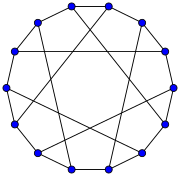Heawood graph
| Heawood graph | |
|---|---|
 |
|
| Named after | Percy John Heawood |
| Vertices | 14 |
| Edges | 21 |
| Radius | 3 |
| Diameter | 3 |
| Girth | 6 |
| Automorphisms | 336 (PGL2(7)) |
| Chromatic number | 2 |
| Chromatic index | 3 |
| Genus | 1 |
| Properties |
Bipartite Cubic Cage Distance-transitive Distance-regular Toroidal Hamiltonian Symmetric Orientably simple |
In the mathematical field of graph theory, the Heawood graph is an undirected graph with 14 vertices and 21 edges, named after Percy John Heawood.
The graph is cubic, and all cycles in the graph have six or more edges. Every smaller cubic graph has shorter cycles, so this graph is the 6-cage, the smallest cubic graph of girth 6. It is a distance-transitive graph (see the Foster census) and therefore distance regular.
There are 24 perfect matchings in the Heawood graph; for each matching, the set of edges not in the matching forms a Hamiltonian cycle. For instance, the figure shows the vertices of the graph placed on a cycle, with the internal diagonals of the cycle forming a matching. By subdividing the cycle edges into two matchings, we can partition the Heawood graph into three perfect matchings (that is, 3-color its edges) in eight different ways. Every two perfect matchings, and every two Hamiltonian cycles, can be transformed into each other by a symmetry of the graph.
There are 28 six-vertex cycles in the Heawood graph. Each 6-cycle is disjoint from exactly three other 6-cycles; among these three 6-cycles, each one is the symmetric difference of the other two. The graph with one node per 6-cycle, and one edge for each disjoint pair of 6-cycles, is the Coxeter graph.
The Heawood graph is a toroidal graph; that is, it can be embedded without crossings onto a torus. One embedding of this type places its vertices and edges into three-dimensional Euclidean space as the set of vertices and edges of a nonconvex polyhedron with the topology of a torus, the Szilassi polyhedron.
...
Wikipedia
